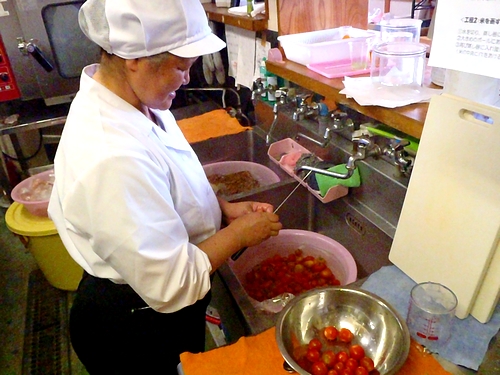Food
Signature local food made from mothers' wisdom and skills lead Fukushima to recovery
2012.08.28 Yoshiaki Seto

Fumiko Watanabe prepares mini tomatoes harvested from the "Ka-tyan Nojo (Mothers' Farm)." Photo by Yoshiaki Seto.
"Tomato kimchee." The fresh, sour taste spreads in your mouth and neutralizes the lingering spiciness of kimchee. It was a very refreshing taste, perfect for the hot summer. Actually you can enjoy it thrice - after you have eaten the tomatoes, you can pour the sauce on rice, and mix the leftover ingredients with cucumbers. This superb tomato kimchee is made by Tokuko Takahashi, a kimchee master who lives in Iitate-mura, Soma-gun, Fukushima Prefecture.
This kimchee is produced and sold by "Ka-tyan No Chikara (Mothers' Power) Project" Mothers involved in this project are originally from residency-restricted areas such as Iitate-mura, Namie-machi, Katsurao-mura, and Kawauchi-mura. Approximately 160,000 people who lived near the Fukushima Nuclear Power Plant still cannot go back home due to the disaster.
After the earthquake, many people who were taking refuge had nearly given up. But all the mothers who used to work hard every day thought, "Things can't stay the way they are. They can't continue to be dependent." "Let's make something and become independent once again." That is why they launched the "Ka-tyan No Chikara (Mothers' Power) Project" in October 2011 with the support of the Fukushima University and town management NPOs.
Now more than ten mothers are taking part in this project. Their sales efforts have been successful. Their lunch boxes and ready-made dishes are being sold at the shelters, university co-ops, the Iitate-mura town hall, etc. All of the 9 well-balanced dishes that go into the "Moms' smiley lunch boxes" are hand made from 6 in the morning. In the future, they will start operating lunch box stands.
All the food made by the project is checked for radiation. The safe limits have been set at 20bq/kg, which is even stricter than the national limit of 100bq/kg. 20bq/kg is nearly at the minimum level of detection. One kilogram of food is required to check for radiation. This means that they must set aside 1kg of lunch boxes, 1kg of cakes, and 1kg of sauces. So 3 handmade lunch boxes equivalent to 1,500 yen must be thrown away for each test. And these tests must be conducted each time a new item is added.
"It was very frustrating, and I cried a lot" said the project leader, Tomiko Watanabe. "But we would have lost the "tastes," the "skills," and the "mothers" if we didn't do anything. I am determined to try hard to preserve the history of the people who have been involved."
Think the Earth is supporting "Ka-tyan's Chikara Project" through "Great East Japan Earthquake - Wasurenai (Let's Not Forget) Project".
Related URL/media










